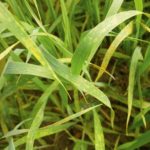Reading Time: 5 minutes New varieties that consistently yield 120 to 140 bushels per acre. Increasing demand, with buyers paying a premium. Competitive against weeds, with good resistance to fusarium. That hardly describes a feed crop you seed last because you need it in rotation. Demand for milling oats is on the rise and processors have announced expansion. Some […] Read more

More than a rotation crop for feed
Demand is increasing for this officially ‘heart healthy’ crop, but growers need to pay attention to quality

Growing quality oats
Recommendations for oat agronomy from the new POGA Oat Growers Manual and research across Western Canada
Reading Time: 6 minutes Soil and rotation Oats grow best in black and grey wooded soil zones that have higher moisture, but can grow on sandy loam to heavy clay soils as long as they have good drainage. To reduce disease pressure and optimize yields, oats should not be grown after cereals. The best rotational crops include canola, hay, […] Read more

The Catch-22 of oat production
Tests in central Alberta yield some useful information on N rates and the effectiveness of plant growth regulators
Reading Time: 4 minutes Linda Hall has a soft spot for the humble oat, mainly because she doesn’t think it’s really all that humble. “Milling oats are a high-value crop,” Hall says. “We’re seeing companies like Richardson buying up oat milling capacity, so the markets are there if we can grow the right kind of oat.” It all depends […] Read more

Get the facts before spending big money on micronutrients
Think you might have a micronutrient deficiency in your fields? Take these four steps before spending any money on micronutrient fertilizer, says Ross McKenzie, who became the province’s best-known fertilizer authority during his lengthy career with the province.

New cereal varieties for Eastern Canada
There’s only a handful of new varieties for planting this fall, but they’re worth a hard look
Reading Time: 2 minutes Increased winter wheat acres are good for Eastern Canada, not only because of crop diversity and longer rotations, but as a contributor to overall soil health. Despite the challenges of fall planting, farmers are clearly deciding there’s real value in maintaining wheat acres: the message is definitely getting through. Yet other, more immediate concerns are[...]
Read more
Read more

Know how to identify these three seedling diseases
Seedling diseases can weaken cereals, leaving plants susceptible to other stresses, Brittney Kroeker told attendees at Bayer’s SeedGrowth Solutions Expo in Saskatoon this spring. Kroeker went through some of the top seedling diseases in cereals. Here are her tips for identifying three seedling disease in cereals.

VIDEO: Underground undies measuring the health of soil
Reading Time: < 1 minute Are you bold enough to soil your undies? The Soil Conservation Council of Canada (SCCC) is and it recently kicked off National Soil Conservation Week by burying several pairs of men’s cotton underwear up to the waistband. After 60 days in six inches of soil, what will it all mean? A healthy soil will show that the[...]
Read more
Read more

Post tucks into British breakfast cereal Weetabix
Reading Time: 3 minutes London/Shanghai/New York | Reuters — Post Holdings is buying leading British breakfast cereal brand Weetabix from China’s Bright Food Group for 1.4 billion pounds (C$2.4 billion), giving the U.S.-focused company a European base on which to build. The combination will help Post’s existing brands, which include Honey Bunches of Oats and Grape-Nuts, to expand overseas,[...]
Read more
Read more

Trade sees record Canadian canola acres as possibility
Reading Time: 2 minutes CNS Canada — Canadian farmers could be set to seed record-large canola acres in 2017, while wheat area is generally expected to be down on the year when Statistics Canada releases its first survey-based acreage estimates of the year on Friday. From a purely economic standpoint, “canola is historically the commodity that pays the bills,”[...]
Read more
Read more

Crown rust comes after oats
Part of the management challenge comes from its sources and its choice as a cover crop
Reading Time: 5 minutes In a production agriculture world where corn and soybeans have dominated the scene for much of the last 25 years, oats are supposedly one of the forgotten crops. There have been attempts to revive the grain’s standing, including the formation of the Oat and Barley Council of Ontario back in the early 2000s, as well[...]
Read more
Read more


